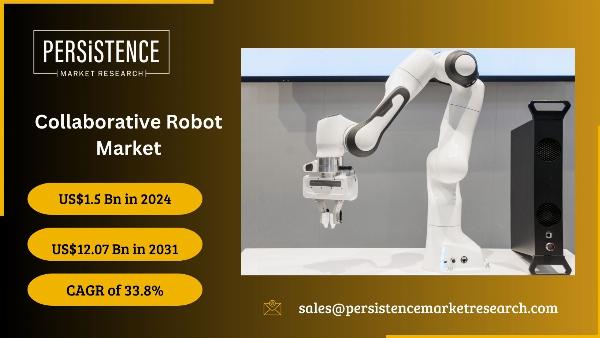Key Trends in Collaborative Robot Growth

Strong 8k brings an ultra-HD IPTV experience to your living room and your pocket.
Collaborative robots, or cobots, represent a significant evolution in robotics technology, characterized by their ability to work alongside humans in a shared workspace. Their rise is transforming various industries by enhancing productivity, improving safety, and driving innovation. This blog explores the key trends driving the growth of collaborative robots, highlighting their impact on the manufacturing sector and beyond. The global collaborative robot market is estimated to value at US$12.07 Bn by the end of 2031 from US$1.24 Bn recorded in 2023. The market is expected to secure a CAGR of 33.8% in the forthcoming years from 2024 to 2031.
1. Increasing Adoption Across Industries
Manufacturing: Traditionally dominated by industrial robots, the manufacturing sector is increasingly adopting collaborative robots to handle tasks like assembly, packaging, and quality inspection. Cobots are valued for their flexibility and ease of integration into existing production lines without requiring extensive reconfiguration.
Healthcare: In healthcare, cobots are making strides in surgical assistance and patient care. Their precision and adaptability enhance surgical procedures and support medical staff in repetitive tasks, improving overall efficiency and patient outcomes.
Logistics: The logistics industry benefits from cobots in warehousing and distribution centers. They assist with sorting, packing, and palletizing, increasing throughput and reducing manual labor while working safely alongside human operators.
Electronics: In electronics manufacturing, cobots handle delicate assembly tasks, manage small components, and ensure high levels of accuracy. Their ability to operate in tight spaces and handle precision tasks makes them ideal for this sector.
2. Advancements in Technology
Improved Sensors and Safety Features: Modern cobots are equipped with advanced sensors and safety features that enable them to operate safely in close proximity to human workers. These sensors enhance their ability to detect and respond to their environment, preventing accidents and ensuring safe interactions.
Enhanced Flexibility and Programming: Advances in user-friendly programming interfaces and machine learning algorithms have made cobots more adaptable to different tasks. Many cobots now offer intuitive programming through graphical interfaces or teach pendant systems, allowing users with minimal robotics expertise to program and deploy them efficiently.
Integration with AI and Machine Learning: The integration of artificial intelligence (AI) and machine learning is enhancing the capabilities of cobots. These technologies enable cobots to learn from their environment, adapt to new tasks, and optimize their performance over time, leading to increased efficiency and versatility.
Connectivity and IoT: Collaborative robots are increasingly connected through the Internet of Things (IoT), enabling real-time data collection, remote monitoring, and predictive maintenance. This connectivity allows for better management of robotic systems and integration into broader Industry 4.0 frameworks.
3. Focus on User Experience and Ergonomics
Ease of Use: Manufacturers are prioritizing user experience in cobot design, focusing on ease of setup, programming, and operation. This user-centric approach is intended to reduce the learning curve for operators and facilitate quicker deployment in diverse applications.
Ergonomic Design: Cobots are designed with ergonomics in mind to ensure they complement human workers effectively. Features such as adjustable arms, lightweight construction, and user-friendly controls contribute to a more comfortable and efficient working environment.
Collaborative Workspace Design: As cobots become more prevalent, there is a growing emphasis on designing collaborative workspaces that optimize human-robot interaction. This includes configuring work areas to accommodate both human and robotic activities while ensuring safety and efficiency.
4. Economic and Operational Benefits
Cost-Effectiveness: Cobots offer a cost-effective solution for automation compared to traditional industrial robots. Their relatively lower upfront cost, combined with reduced need for specialized infrastructure, makes them an attractive option for small and medium-sized enterprises (SMEs).
Increased Productivity: Collaborative robots enhance productivity by performing repetitive or labor-intensive tasks with high precision and consistency. This allows human workers to focus on more complex and value-added activities, leading to overall improvements in operational efficiency.
Flexibility and Scalability: The ability to easily reconfigure and adapt to different tasks makes cobots a flexible and scalable solution for businesses. Companies can deploy cobots in various applications and scale their operations without significant investment in new equipment or infrastructure.
5. Regulatory and Standardization Developments
Safety Standards: As cobots become more widely adopted, there is a growing focus on establishing and updating safety standards to ensure their safe integration into work environments. Organizations such as the International Organization for Standardization (ISO) are developing guidelines and standards to address safety and performance concerns.
Regulatory Compliance: Compliance with industry regulations and standards is crucial for the deployment of cobots in various sectors. Manufacturers are working to ensure their products meet regulatory requirements and adhere to best practices for safety and performance.
6. Emerging Applications and Market Opportunities
Education and Research: Cobots are increasingly used in educational settings and research facilities for teaching robotics and automation principles. Their ease of use and adaptability make them valuable tools for training future generations of engineers and scientists.
Agriculture: In agriculture, cobots are being explored for tasks such as planting, harvesting, and sorting. Their ability to operate in diverse environments and handle delicate crops presents new opportunities for automation in this sector.
Consumer Goods: The consumer goods industry is leveraging cobots for packaging, labeling, and quality control. Their flexibility allows for efficient handling of various products and packaging formats, improving efficiency in production lines.
7. Challenges and Considerations
Integration Challenges: While cobots offer numerous benefits, integrating them into existing processes and workflows can present challenges. Businesses need to consider factors such as system compatibility, training requirements, and potential disruptions during the transition.
Workforce Impact: The adoption of cobots may impact the workforce, leading to concerns about job displacement. Companies must address these concerns by providing training and upskilling opportunities for employees to work alongside and manage robotic systems.
Data Security: As cobots become more connected and integrated into networked systems, data security becomes a critical concern. Ensuring robust cybersecurity measures and protecting sensitive information are essential for maintaining trust and integrity in robotic systems.
Conclusion
The collaborative robot market is experiencing dynamic growth, driven by advancements in technology, increased adoption across industries, and a focus on user experience and economic benefits. As cobots continue to evolve, they offer significant opportunities for enhancing productivity, safety, and efficiency in various sectors. However, businesses must navigate challenges related to integration, workforce impact, and data security to fully capitalize on the potential of collaborative robots.
By staying abreast of key trends and embracing innovative approaches, organizations can harness the power of cobots to drive success and innovation in their operations.
Follow Us: LinkedIn | Medium | Twitter
Note: IndiBlogHub features both user-submitted and editorial content. We do not verify third-party contributions. Read our Disclaimer and Privacy Policyfor details.







